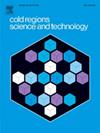Analytical solution of steady-state temperature field of arc-shaped three-pipe liquid nitrogen freezing under adiabatic boundary condition
IF 3.8
2区 工程技术
Q1 ENGINEERING, CIVIL
引用次数: 0
Abstract
Sudden seepage and leakage in underground engineering retaining structures are often mitigated using artificial liquid nitrogen freezing. However, the development of frozen soil curtains during liquid nitrogen freezing is frequently influenced by adjacent pile foundations and other structures. Currently, no theoretical solution exists for the temperature field distribution under these conditions. To investigate the temperature field distribution under adiabatic boundaries, such as adjacent pile foundations, and to understand the development of the freezing curtain under local adiabatic boundary constraints, a steady-state temperature field analytical solution of arc-shaped three-pipe liquid nitrogen freezing was derived using thermal potential superposition theory and the mirror method. This analytical solution for different characteristic sections was then contrasted with numerical simulations and model test results to verify its accuracy and applicability. Results indicate that the analytical solution aligns with the steady-state numerical solution, and the freezing model transitions from an unsteady to a quasi-steady state. The error compared to the transient numerical solution decreases over time, from 15.3 °C on the 10th day to 0.3 °C by the 50th day. The applicability and accuracy of the analytical solution are further validated using auxiliary interfaces. Comparing the analytical solution with model test results reveals that isotherms are perpendicular to the adiabatic boundary, with heat flow parallel to the boundary and no normal heat flow. The adiabatic boundary notably enhances the temperature field distribution and freezing efficiency. Finally, the accuracy of the analytical solution of the liquid nitrogen freezing model meets the requirements of practical engineering applications.
绝热边界条件下弧形三管液氮冻结稳态温度场解析解
地下工程围护结构突发性渗漏常采用人工液氮冻结的方法来缓解。然而,在液氮冻结过程中,冻土帷幕的发展经常受到邻近桩基和其他结构的影响。目前,对于这些条件下的温度场分布还没有理论解。为了研究邻近桩基等绝热边界下的温度场分布,了解局部绝热边界约束下冻结幕的发展情况,利用热势叠加理论和镜像法推导了弧形三管液氮冻结的稳态温度场解析解。并将该解析解与数值模拟和模型试验结果进行对比,验证了该解析解的准确性和适用性。结果表明,解析解与稳态数值解一致,冻结模型由非定常状态过渡到准稳态状态。与瞬态数值解相比,误差随着时间的推移而减小,从第10天的15.3°C到第50天的0.3°C。利用辅助接口进一步验证了解析解的适用性和准确性。解析解与模型试验结果比较表明,等温线垂直于绝热边界,热流平行于绝热边界,无正流式。绝热边界显著提高了温度场分布和冻结效率。最后,液氮冻结模型解析解的精度满足实际工程应用的要求。
本文章由计算机程序翻译,如有差异,请以英文原文为准。
求助全文
约1分钟内获得全文
求助全文
来源期刊

Cold Regions Science and Technology
工程技术-地球科学综合
CiteScore
7.40
自引率
12.20%
发文量
209
审稿时长
4.9 months
期刊介绍:
Cold Regions Science and Technology is an international journal dealing with the science and technical problems of cold environments in both the polar regions and more temperate locations. It includes fundamental aspects of cryospheric sciences which have applications for cold regions problems as well as engineering topics which relate to the cryosphere.
Emphasis is given to applied science with broad coverage of the physical and mechanical aspects of ice (including glaciers and sea ice), snow and snow avalanches, ice-water systems, ice-bonded soils and permafrost.
Relevant aspects of Earth science, materials science, offshore and river ice engineering are also of primary interest. These include icing of ships and structures as well as trafficability in cold environments. Technological advances for cold regions in research, development, and engineering practice are relevant to the journal. Theoretical papers must include a detailed discussion of the potential application of the theory to address cold regions problems. The journal serves a wide range of specialists, providing a medium for interdisciplinary communication and a convenient source of reference.
 求助内容:
求助内容: 应助结果提醒方式:
应助结果提醒方式:


